Original Author: Ryan Yoon, Tiger Research
TL;DR
· Stable positions itself as the "Trojan Horse" of the stablecoin market, promoting mass adoption by focusing on the infrastructure of USDT.
· It offers gas-free USDT transfers, sub-second settlement, and a simplified user interface to address key barriers such as high fees, slow transactions, and complex usage.
· The expected roadmap is to attract users first with free, seamless transfers, then gradually expand into payments, DeFi services, and institutional partnerships.
I. Stablecoins: Entering the Market as a Trojan Horse
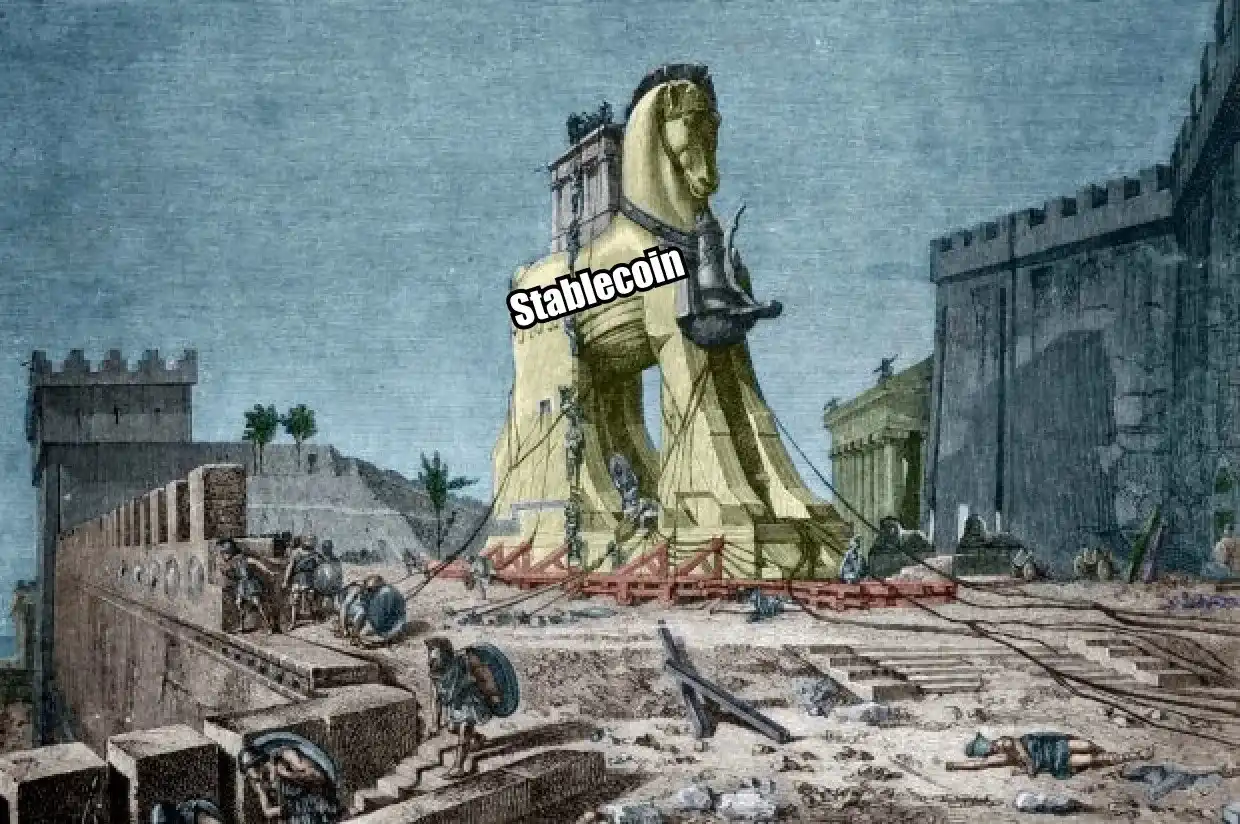
Stablecoins have quietly entered the cryptocurrency market, much like a Trojan Horse.
Since then, they have gradually grown into a dominant force within the ecosystem. Initially, they were mainly seen as a tool for hedging volatility. Over time, they have evolved into a core component of market infrastructure.
The stablecoin market, led by USDT, now has a circulation of over $150 billion, with more than 350 million users, and trading volumes that even surpass Visa. This makes stablecoins not just crypto assets, but also a truly operational global payment network.
Their growth reflects a bridging role between traditional finance and digital finance. In centralized exchanges, stablecoins are the primary medium for exchanging fiat and cryptocurrencies. In decentralized finance (DeFi), they serve as benchmark assets for liquidity provision and lending. In the cross-border remittance sector, they offer a faster and more cost-effective alternative compared to traditional banks.
The shift in market behavior is also significant. Early crypto trading relied on direct token-to-token exchanges, such as BTC/ETH or BNB/ETH, where value was often measured in Bitcoin. Today, trading pairs like BTC/USDT and ETH/USDT dominate. DeFi yields are often denominated in USDT. In some regions of Southeast Asia and Latin America, USDT is increasingly being used for direct payments, replacing physical dollars.
Markets that once relied on the valuation of volatile tokens have now seen stablecoins become the universal unit of account.
They were initially introduced out of necessity, but have now become the central axis of the cryptocurrency ecosystem.
II. The Other Side of Growth: The Emergence of Infrastructure Limitations
Rapid expansion has also exposed structural weaknesses. The current stablecoin infrastructure faces three key constraints.
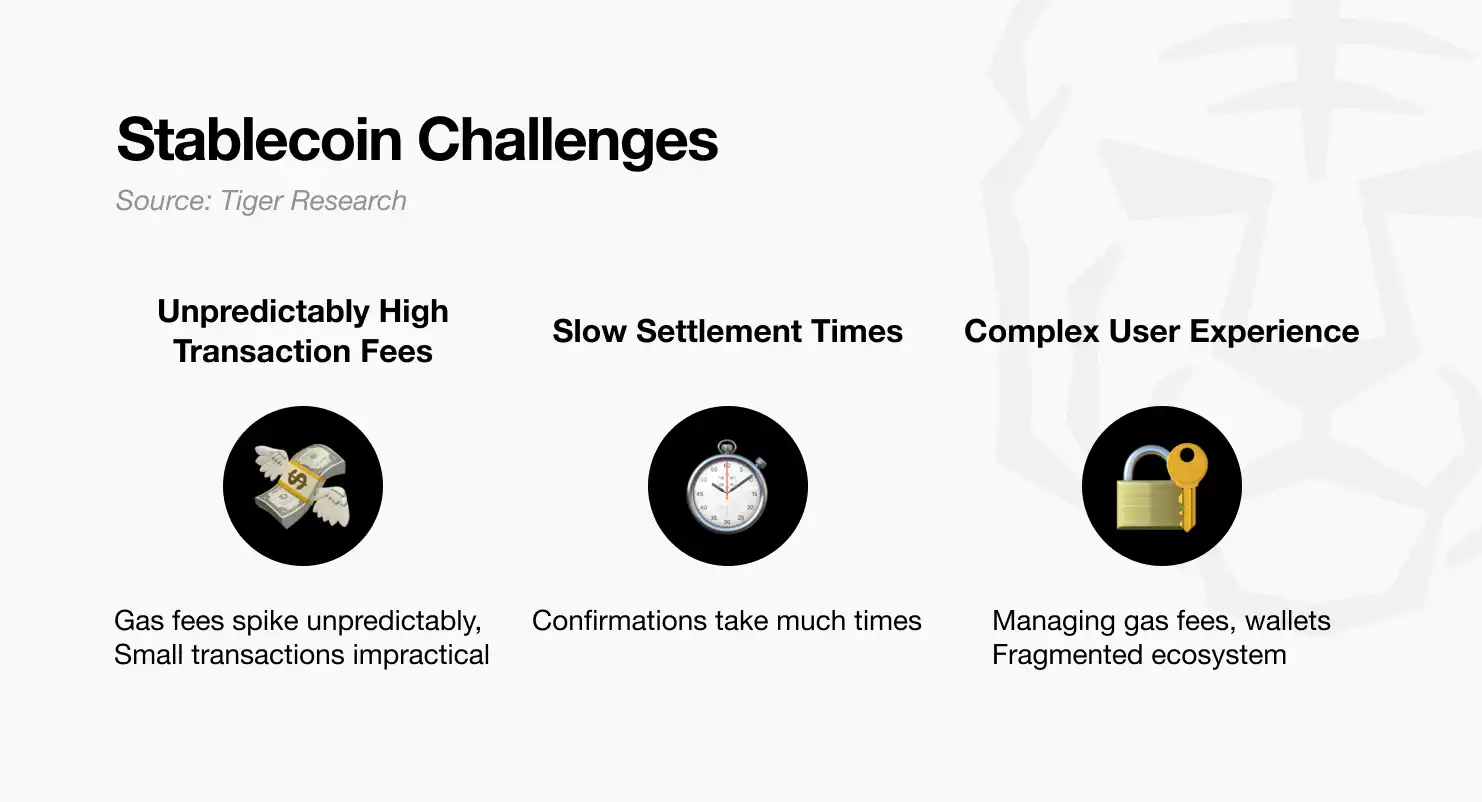
Source: Tiger Research
· Unpredictably high transaction fees: Stablecoins operate on multiple blockchain networks, but when networks become congested, gas fees can skyrocket, making small transactions unfeasible. In some cases, transferring $10 could incur a fee of $20. This directly undermines the core value of stablecoins as everyday payment tools.
· Slow settlement times: On Ethereum, stablecoin transactions can take several minutes or longer to confirm, depending on the network conditions at the time. For scenarios that require real-time settlement, such as online checkouts or offline retail, such delays are nearly unacceptable.
· Complex user experience: For most average users, calculating gas fees, using wallets, and managing private keys still pose significant barriers. In contrast, consumers are already accustomed to simple and intuitive payment interfaces like PayPal, while the current stablecoin experience feels overly complicated.
These limitations in infrastructure pose significant obstacles for stablecoins to enter the next stage of development. Ironically, within the cryptocurrency ecosystem, stablecoins have become the de facto benchmark asset, yet their everyday usability remains low for mainstream users.
Stablecoins have completed their initial mission as a Trojan Horse: bringing stability to a turbulent market and establishing themselves as the core of the ecosystem.
The next challenge lies outside the crypto world: penetrating traditional financial markets and mainstream consumer payment systems. To achieve this, existing technological constraints must be fundamentally addressed, requiring a new "Trojan Horse" strategy.
III. The New Trojan Horse: Stable
Creating a new Trojan Horse does not require inventing another stablecoin. Stablecoins are essentially tools pegged to the dollar. The new Trojan Horse is dedicated infrastructure built for existing and market-dominating stablecoins.
 Source: Stable
Source: Stable
This is the significance of Stable. Unlike generic blockchains, Stable is a chain specifically built for USDT. It does not merely support the coexistence of USDT with other tokens, but serves as a dedicated high-speed network specifically for processing USDT transactions.
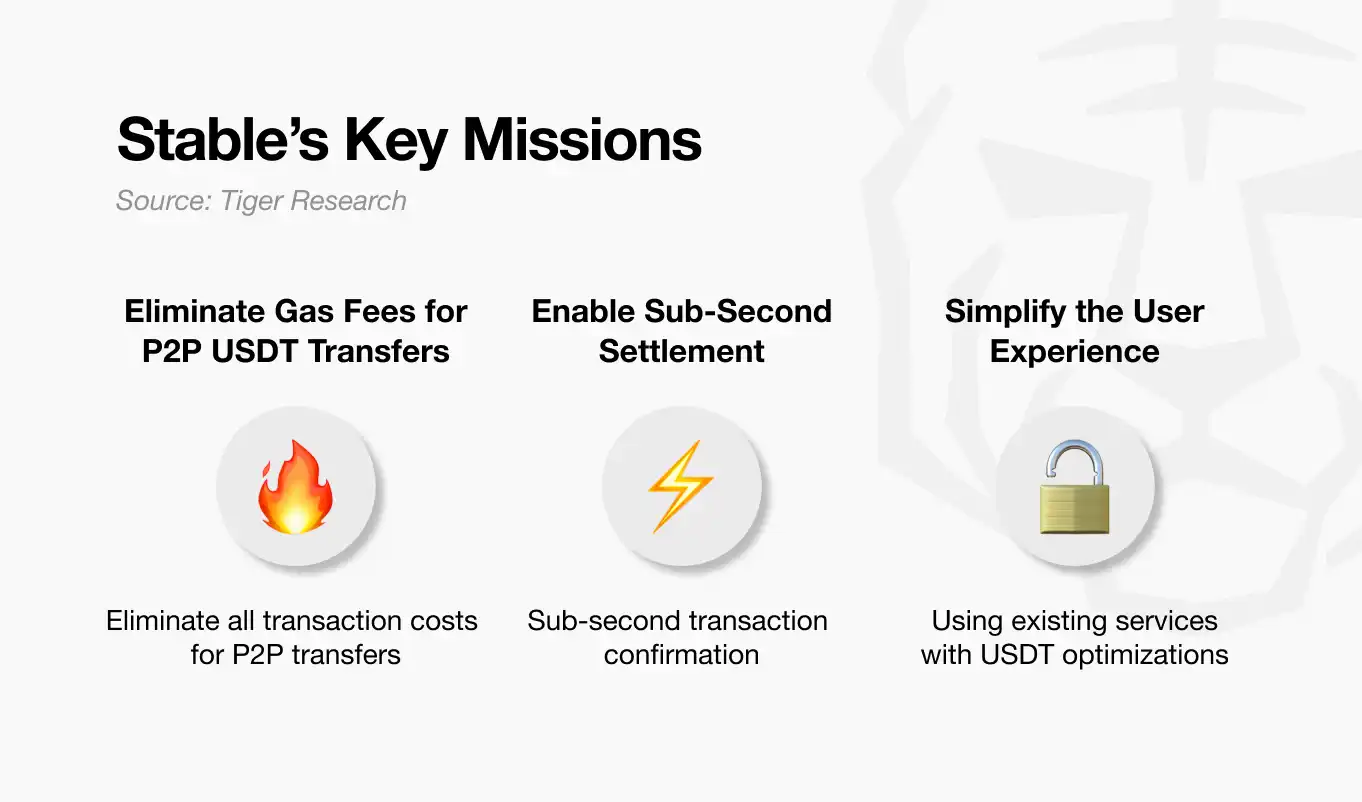
Source: Tiger Research
Stable's mission has three points:
· Eliminate gas fees for USDT peer-to-peer transfers: Completely remove gas costs to address the inefficiency where even a $10 transfer could incur high fees on existing networks.
· Achieve sub-second settlement: All transactions are settled within one second, eliminating the common wait times in online and offline payments.
· Simplify user experience: Shield users from the complexities of gas fee calculations and wallet management, allowing them to operate as intuitively as traditional payment tools without technical burdens.
The key is that these improvements are interrelated. Removing gas fees simplifies the user experience, while faster transaction processing enhances usability in real-world business environments. Together, these factors lay the foundation for stablecoins to move out of the crypto world and into mainstream payment markets.
Stable's vision is not to become just another ordinary blockchain, but to be the core infrastructure supporting the USDT ecosystem. With a market size of $160 billion for USDT, Stable aims to meet this massive market demand by addressing the structural limitations in existing stablecoin infrastructure—such as unpredictable fees, slow settlement speeds, and complex user interfaces.
Its direction is to break away from the fragmented model where each chain independently supports USDT, and instead build a unified environment optimized for USDT operations.
IV. The Operational Mechanism of the Architecture

Source: Stable
To ensure that Stable's core vision operates in practice, multiple technical elements must work in synergy. Stable is currently still in the testnet phase, and the team is preparing for the mainnet launch. Its target architecture clearly demonstrates how the system operates.
Gas-Free USDT0 Transfers: EIP-7702 and Account Abstraction
The Stable network operates with two types of tokens.
USDT0 represents USDT that has been bridged from external networks. gasUSDT is a token specifically used to pay network fees, pegged 1:1 to USDT0 and can only be used for transaction fee payments. Both can be exchanged 1:1 for real USDT.
To achieve gas-free peer-to-peer transfers, Stable employs EIP-7702 and Account Abstraction. This way, users only need to hold USDT0 to complete all transactions.
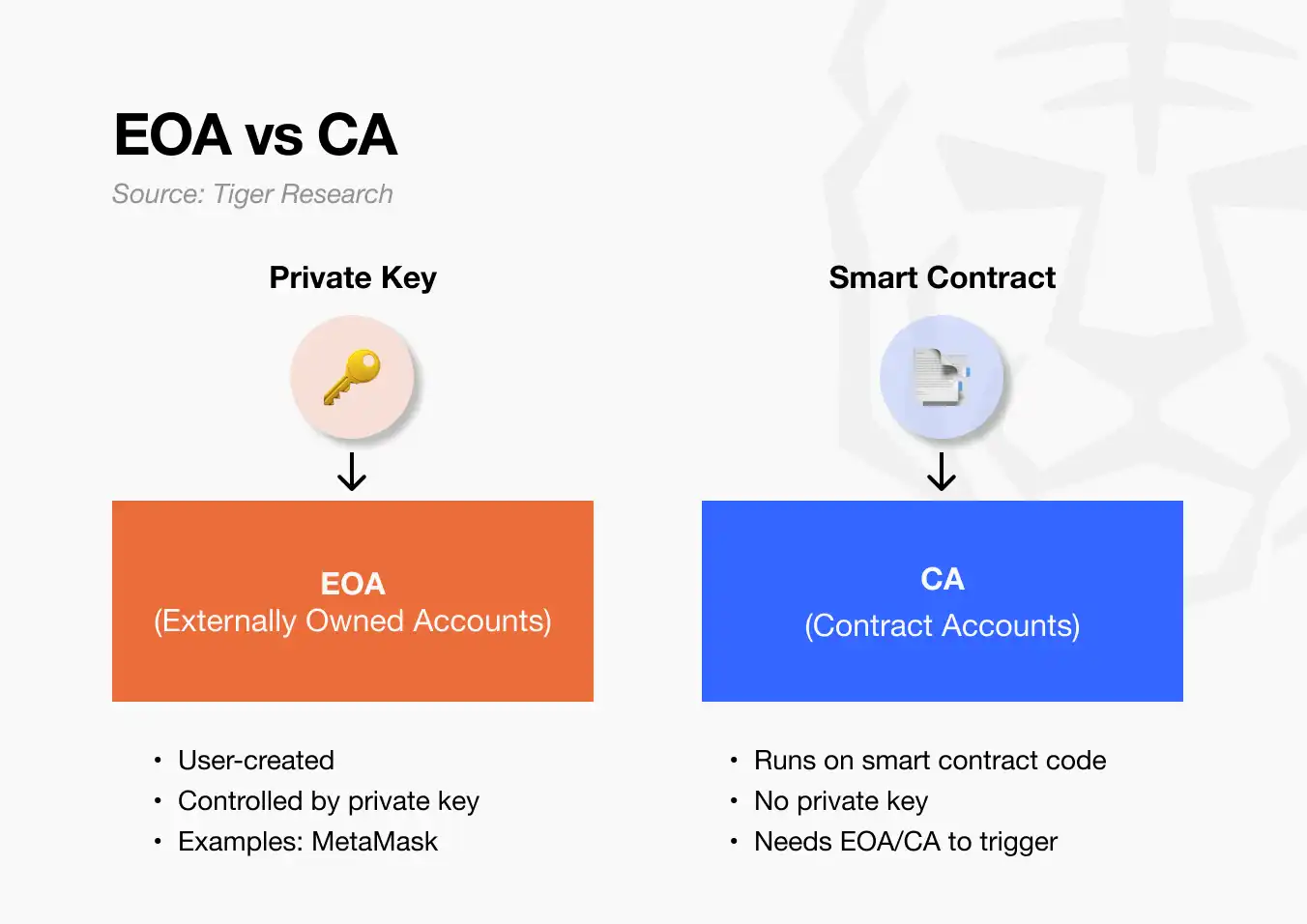
Source: Tiger Research
In existing blockchain systems, accounts are mainly divided into two categories:
· Externally Owned Accounts (EOA): Standard wallets (e.g., MetaMask) controlled by private keys, capable of signing transactions but with limited functionality.
· Contract Accounts (CA): Smart contract accounts that can execute complex logic but cannot initiate transactions on their own.
Account Abstraction merges these two types of accounts, enabling standard wallets to possess smart contract functionality. Users can thus directly specify, for example, "pay gas with USDT" or "request gas fee exemption."
The first attempt to address this issue was the ERC-4337 standard, which requires users to create a new smart wallet and transfer funds from the original wallet to the new one, a process that is prone to user error.
· Previous method: Create a new smart wallet → Transfer funds from the original wallet → Use the new address
· EIP-7702 method: Retain the original wallet → Add smart contract functionality → Address remains unchanged
EIP-7702 eliminates the migration step, allowing existing wallet addresses to directly gain smart functionality without moving funds. Users can continue using their original MetaMask wallet, now with added smart capabilities.
In Stable, all wallets natively support EIP-7702, so smart wallet functionality can be used without additional setup. This includes features like gas fee sponsorship, which can be directly enabled in existing wallets.
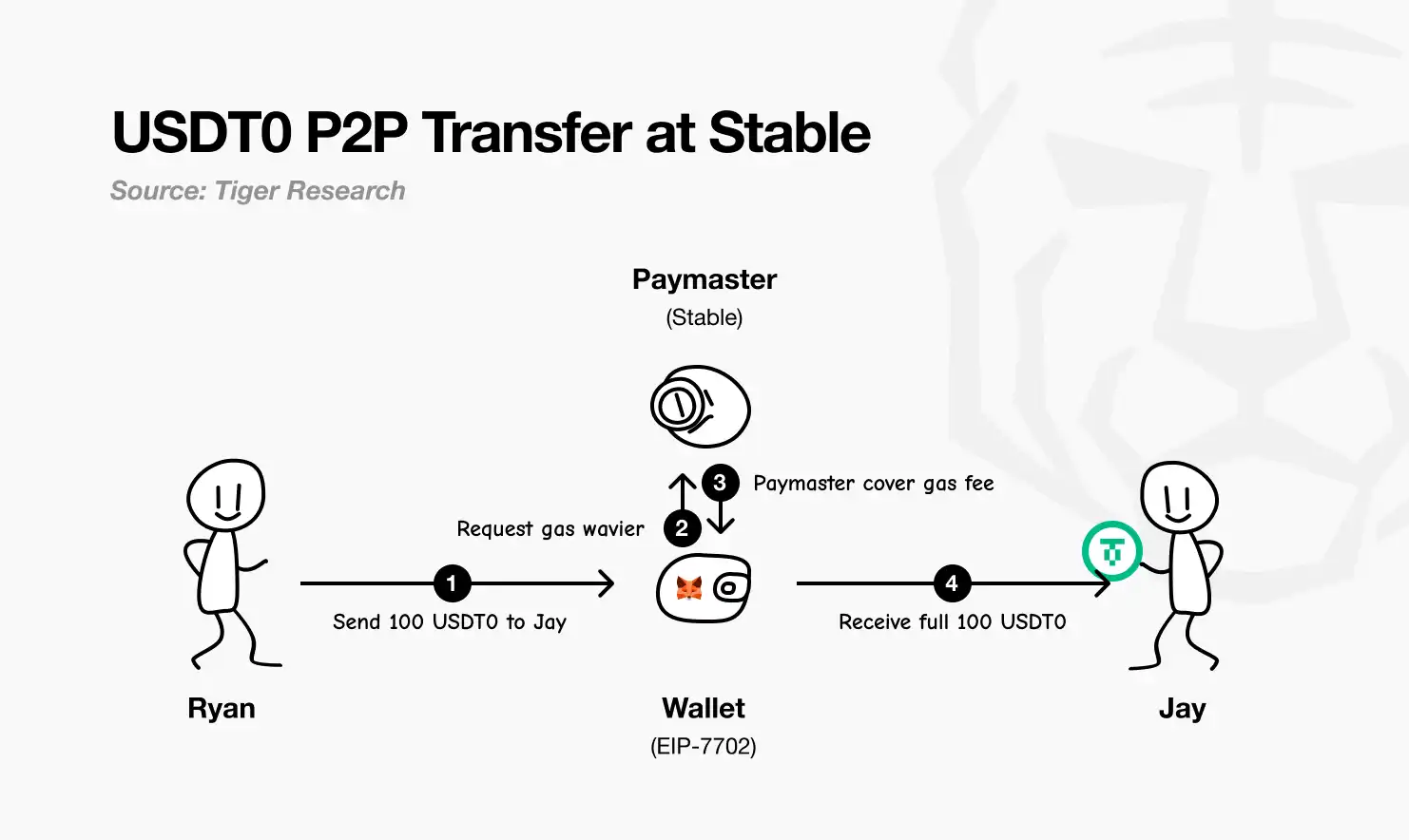
Source: Tiger Research
Example:
· Ryan transfers 100 USDT0 to Jay via MetaMask.
· The wallet, supporting EIP-7702, requests a gas fee exemption.
· The Paymaster service provider pays the gas for the transaction.
· Ryan's balance decreases by exactly 100 USDT0, and Jay receives a full 100 USDT0.
No additional gas is deducted in the process, and Ryan does not need to hold or calculate fees, making the experience akin to using PayPal for transfers. This means there is no need to hold gas tokens separately or manually calculate transaction fees.
Sub-Second Transaction Finality
Stable adopts the StableBFT consensus algorithm, producing a block approximately every 0.7 seconds, with transactions achieving finality after a single confirmation. This eliminates the common "pending confirmation" phase found in many blockchains, providing an experience similar to instant approval at payment terminals.
To further accelerate speed, Stable is developing Block-STM parallel processing, capable of executing independent transactions simultaneously, which account for 60% to 80% of network activity. This approach is akin to having multiple checkout counters open in a supermarket, thereby reducing wait times.
In the longer-term plan, Stable intends to upgrade to an Autobahn DAG consensus structure. This architecture allows multiple blocks to be proposed simultaneously and separates data propagation from ordering, reducing bottlenecks. Internal testing has shown that its throughput can reach up to 200,000 transactions per second, but it is still in the pre-production phase.
Simplified User Experience
Stable removes the burden of gas fee calculations and separate gas token management while maintaining compatibility with the Ethereum ecosystem. Users can continue to use familiar tools like MetaMask and Etherscan without additional learning.
On this basis, these tools will operate more smoothly under USDT optimization: MetaMask supports gas-free USDT0 transfers, while Etherscan presents USDT transaction records in a more intuitive manner.
It's like upgrading to a new phone while still having access to all the original apps. Users retain their familiar environment while gaining enhanced features.
USDT from other networks can also be seamlessly imported via the existing LayerZero cross-chain bridge. USDT0 uses the LayerZero OFT (Omnichain Fungible Token) standard, fundamentally addressing the complexities of traditional cross-chain operations. In the traditional model, each network maintains a separate version of USDT, leading to fragmented liquidity.
With the adoption of the OFT standard, USDT0 is completely consistent across all networks. Whether bridged from Ethereum or Arbitrum, the resulting USDT0 is the same, eliminating liquidity fragmentation and simplifying asset transfers.
Future plans also include the Stable Name System, which will replace complex wallet addresses with human-readable names, further enhancing usability. Similar to email addresses, users will be able to send funds directly to identifiers like "ryan.stable" or "jay.stable." Although still in the planning stage, implementation and widespread adoption may take time. From a technical perspective, it is expected to adopt a structure similar to Ethereum ENS (Ethereum Name Service) but will include features optimized for USDT transactions.
Other Technical Components
The network is also developing StableDB, a specialized database architecture that separates state submission from state storage.
In most blockchains, new blocks must be fully written to disk before the next block can be processed, and the latency of disk writes can slow down processing speed. StableDB eliminates this bottleneck by confirming execution results in memory first and then writing to disk in parallel.
This architecture also incorporates memory-mapped file I/O (mmap), which directly maps files stored on disk into the operating system's memory space, making read and write operations for frequently used data nearly indistinguishable from in-memory operations, thus bypassing slower disk access and significantly improving processing speed. The effect is similar to a restaurant where the waiter quickly writes down the order, and the kitchen immediately starts preparing, with the order later entered into the cash register.
For enterprise clients, Stable plans to introduce "guaranteed block space," which allocates a portion of transaction capacity to ensure stable throughput even during network congestion, much like a bus lane on a highway. Additionally, a "confidential transfer" feature is also in development, which can hide transaction amounts while complying with anti-money laundering and KYC regulations. Looking ahead, the current execution engine written in Go will be replaced with a C++-based StableVM++. This upgrade will provide lower-level memory control and performance optimization, aiming for up to six times the execution speed improvement.
V. Expansion Scenarios for the Stable Ecosystem
Stable positions itself as a new "Trojan Horse."
Gas-free USDT transfers, sub-second settlement, and a simplified user experience are all entry incentives to attract users. This "loss-leading" strategy aims to drive mass adoption. Once a user base is established, Stable can generate revenue through a wide range of supporting services.
Based on this foundation, three main expansion paths seem most viable.
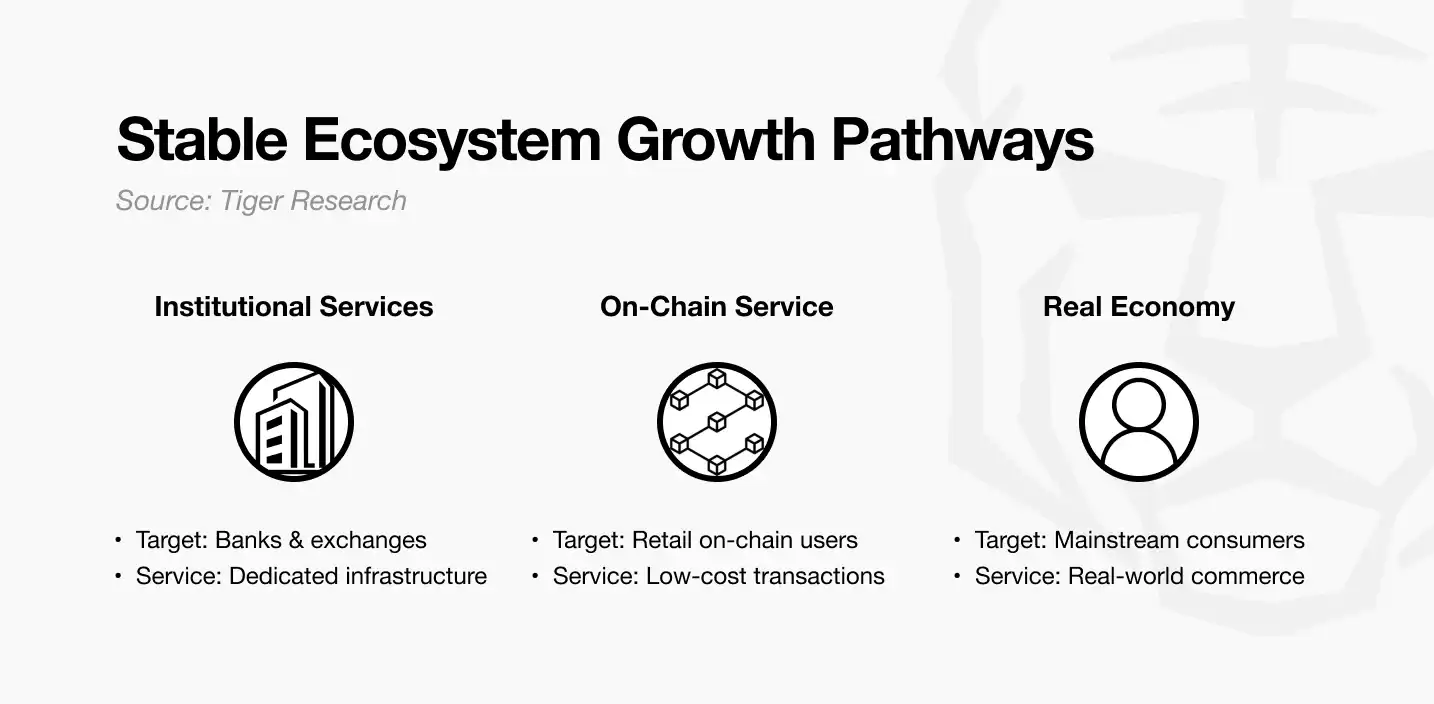
Source: Tiger Research
Scenario 1: Expansion of Institutional Services and Partnerships
Stable can expand its ecosystem by broadening institutional services and partnerships. A key factor is high-end services like "guaranteed block space," which ensure low costs and high reliability.
This strategy is particularly effective in corporate cross-border settlements. Using Stable instead of traditional international transfers can significantly reduce time and costs. However, during peak periods like month-end, processing speed becomes critical. Dedicated block space can ensure consistent speed, and companies are willing to pay a premium for this reliability.
The same logic applies to fintech partnerships. Remittance companies like Limitless and Wise can integrate Stable's infrastructure to provide better services to their customers; in return, Stable charges fees based on transaction volume.
This model is also applicable to cryptocurrency trading platforms. Trading platforms can rely on Stable for USDT deposits and withdrawals, gaining a reliable partner. While individual users can use these services for free, the real business target is high-frequency institutional traders.
Scenario 2: Rapid Growth of On-Chain Service Ecosystem
Free transfers and high-speed performance will greatly increase the frequency of on-chain service usage. Currently, even a $10 DeFi transaction on Ethereum often incurs high gas fees. On Stable, small-scale DeFi operations become economically viable.
Users can invest $100 in liquidity or participate in staking without incurring significant costs, which will expand the DeFi user base. Stable profits from the smart contract execution fees of these activities, and as transaction volumes grow, the overall scale will also expand.
A more significant change is the emergence of new on-chain services. Real-time micro-payments will enable content subscriptions, in-game items, and tips to be completed directly on the blockchain. Paying a YouTube creator $1 or $0.10 for a news article becomes possible.
Once this micro-payment ecosystem is established, the number of transactions will grow exponentially. While individual fees may be small, the accumulated transaction volume will reach a considerable scale.
Scenario 3: Deep Integration with the Real Economy
The most ambitious scenario is for stablecoins to become a standard payment method in the real economy. In Southeast Asia and Latin America, USDT payments are already on the rise, but high fees and low speeds limit adoption.
If Stable can solve these issues, offline commerce may undergo rapid transformation. Spending $2 on coffee in a café in Vietnam or using USDT to buy daily necessities at a convenience store in the Philippines could become commonplace.
This would fundamentally change Stable's business model, transforming it from a blockchain network into a provider of global payment infrastructure. It could offer payment terminals to merchants and digital wallets to consumers, charging fees from both sides.
By charging a minimal fee on every USDT transaction occurring within the Stable network, it can establish a stable revenue base as transaction volumes grow.
The delayed rollout of central bank digital currencies (CBDCs) also presents an opportunity. If private stablecoins are more convenient and accessible than government-issued digital currencies, users will naturally choose the former.
VI. The True Strategy of Stable
Stable's strategy is very clear: attract users through free USDT transfers and ease of use. As the ecosystem expands, it will build a business model around the diverse services that emerge from this.
While individual transactions may not generate much revenue, the rapidly growing transaction volume can create a massive overall scale. This is similar to Amazon's early strategy: selling books at near-cost to attract customers, then generating huge profits through cloud services and advertising.
Free transfers are merely bait. The real goal is to become the central hub of the USDT ecosystem, ensuring that all transactions pass through Stable. Once the network effect is established, it will be difficult for users to migrate to other platforms.
Ultimately, Stable will firmly establish its market position. This is the true power of the new Trojan Horse.
免责声明:本文章仅代表作者个人观点,不代表本平台的立场和观点。本文章仅供信息分享,不构成对任何人的任何投资建议。用户与作者之间的任何争议,与本平台无关。如网页中刊载的文章或图片涉及侵权,请提供相关的权利证明和身份证明发送邮件到support@aicoin.com,本平台相关工作人员将会进行核查。




